MIDI Devices
Before delving into the details of MIDI software messages, Let's define the types of logical MIDI devices we'll be discussing. There is a plethora of MIDI-enabled devices providing a variety of features and functions. Rather than trying to catalog and categorize everything out there, let's simplify the landscape by looking at the four basic logical groups of MIDI devices that we'll be discussing in this series of articles:
- Synthesizers
- Controllers
- Sequencers
- Networks
Synthesizers
MIDI syntheiszers are components that generate sounds based on the input of MIDI software messages. Musically speaking, MIDI synthesizers create pitched and/or percussion sounds. This definition is seemingly simple in concept, but keep in mind there are a variety of MIDI synthesizers employing various technologies such as MIDI software, hardware, and digital- or analog-synthesis. There is also a plethora a specific, technical terminology that's been coined to describe these MIDI devices. The key feature of MIDI synthesizers is that they produce musical tones and percussion based on the input of MIDI software messages.
One point does require further distinction. Synthesizers are NOT necessarily integrated with a keyboard. Rack-mounted MIDI synthesizers and MIDI-enabled computer sound cards are both examples of MIDI synthesizers that aren't integrated with a MIDI controller such as a keyboard. Another good example of the of the keyboard-less MIDI sythisizer is the drum machine. In short, the MIDI synthesizer generates music based on MIDI software messgaes but it doesn't need to be integrated with a controller.
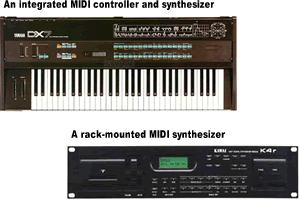
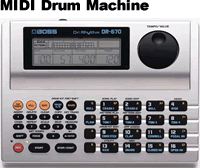
Controllers
MIDI controllers are the MIDI devices that musicans physically manipulate to generate MIDI software messages. MIDI controllers can take the form of almost any acoustic or electronic instrument such as keyboards, guitars,
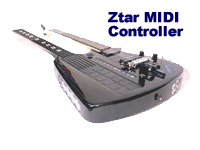 drum sets, drum pads, and even woodwind-like instruments. Keep in mind that a controller does NOT synthesize or generate audible music. MIDI controllers generate MIDI software messages that are routed through one or more MIDI ports. That said, MIDI controllers are commonly integrated with a synthesizer because controllers without an integrated synthesizer aren't very interesting for cost-conscious musicians. Of course the most typical integrated product is the MIDI keyboard controller and synthesizer packaged into a single unti. The Ztar shown to the right and the Yamaha WX5 shown below are examples of non-keyboard controllers that are not integrated with a synthesizer.
drum sets, drum pads, and even woodwind-like instruments. Keep in mind that a controller does NOT synthesize or generate audible music. MIDI controllers generate MIDI software messages that are routed through one or more MIDI ports. That said, MIDI controllers are commonly integrated with a synthesizer because controllers without an integrated synthesizer aren't very interesting for cost-conscious musicians. Of course the most typical integrated product is the MIDI keyboard controller and synthesizer packaged into a single unti. The Ztar shown to the right and the Yamaha WX5 shown below are examples of non-keyboard controllers that are not integrated with a synthesizer.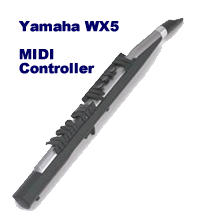
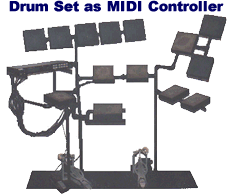
Sequencers
The MIDI sequencer is an electronic device incorporating both MIDI software and hardware, which is used for storing and replaying MIDI software message sequences. In effect, the sequencer is the electronic version of the musician in the MIDI world. Early on, most of the available sequencers were physical devices with small cryptic displays and a keypad for control and data entry. Since then, music composition software such as Tonalsoft's Tonescape have come to dominate the niche for MIDI sequencers. Software sequencers are ideal since they can easily show two faces to the world: (a) their human face enables musicans to see and edit a MIDI sequence using a familiar notation such as staff notation or piano roll, and (b) their machine face provides a MIDI software message port that communicates directly with other MIDI enabled devices. Here's the important point from this paragraph: logically, a MIDI sequencer (a) records MIDI software message sequences, (b) replays MIDI software sequences using the appropriate timing, and (c) provides some sort of editing capabilities.
networks
The last logical MIDI device that we'll be discussing is the network itself. In fact, the concept of the MIDI network is just a generalization of a device called the Patch Bay. A MIDI network is a combination of hardware and software that provides interconnectivity between a group of MIDI devices, such as synthesizers, controllers, and sequencers.
In the MIDI universe, a logical connection between two devices is accomplished over a MIDI port. There are MIDI-in and MIDI-out ports. As the name implies, MIDI-in ports accept data that's sent from another device; while MIDI-out ports send MIDI software messages to other devices' input ports. There's also a port called the pass-through or MIDI-thru port. As the name suggests, the MIDI Thru passes incoming MIDI software messages to the MIDI device's MIDI-out port. I'll get into the details of MIDI ports in the next installment of The Pitch Bend. A MIDI network may contain one or more logical MIDI ports that interconnect dozens of MIDI devices. Notice the use of the word "logical". Originally, a MIDI port was a specific type of plug (outlet) with a specific type of cable. As time progressed, MIDI became available over a variety of cables and networking hardware. In some instances, a single physical connection can provide the same features as multiple logical MIDI ports. We'll discuss the MIDI port in more detail in the next installment of this series.
putting it all together
Let's take a look at how a two-person band can employ MIDI to get a much larger sound during a live performance. Our band has two instrumentalists, a lead guitarist, and a drummer. Although they have a strong repretoire, they're in need of adding a bass guitar, piano, and string section. The MIDI setup shown below will help them out. In addition to the traditional electric guitar and drum set, our band has two rack-mounted MIDI synthesizers, a patch bay, and a hardware sequencer.
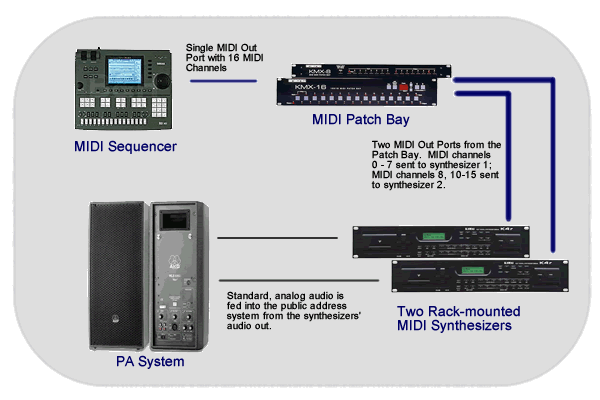
In this example, the drummer directly controls the sequencer to start and stop the accompanying parts, bass guitar, piano, and string section. When a sequence is started, the sequencer sends the MIDI software messages to the patch bay in real time. The patch bay configuration then ensures that the correct messages are sent the correct syntheiszer. In this diagram, one of the rack-mounted MIDI synthesizers is used for both the bass-guitar and the string section, while the other is dedicated to the piano parts.
Since this is a technical column, we'll discuss all index-based numbers on a zero basis. In other words, the first MIDI channel to the musician is "1", to the technical person, it's really channel "0". That's because when someone selects MIDI channel 1, the underlying hardware and/or software are actually working with the number 0 as the MIDI channel number. Next week, I'll get a little more technical. I hope you join me on our discussion about MIDI ports.
